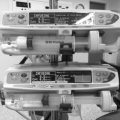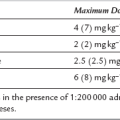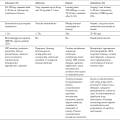Day-Case Anaesthesia
The NHS plan predicts that 75% of all elective operations will be carried out as day cases. According to the British Association of Day Surgery (BADS), patients support day surgery because it provides timely treatment, less risk of cancellation, a lower incidence of hospital-acquired infection and an earlier return to normal activities. Procedures commonly selected for day-case care are those which take < 60 min to complete and which do not cause severe haemorrhage or produce excessive amounts of postoperative pain (Table 26.1). Increasingly complex cases are now performed as day-case procedures, including laparoscopic cholecystectomy and tonsillectomy. By extending day surgery opening hours and using staggered admission times, patients who would normally require hospital admission may be treated as day cases. The British Association of Day Surgery (BADS) publishes guidelines and protocols for the management of specific issues: for example, day surgery for patients with diabetes. BADS has also published a list of 25 procedures which should normally be undertaken as day cases. The NHS Modernisation Agency audited current day surgery rates for these procedures and set target rates for individual hospitals.
TABLE 26.1
A Selection of Surgical Procedures Commonly Undertaken as Day Cases
Gynaecology
Dilatation & curettage, laparoscopy, vaginal termination of pregnancy, colposcopy, hysteroscopy
Plastic Surgery
Dupuytren’s contracture release, removal of small skin lesions, nerve decompression
Ophthalmology
Strabismus correction, cataract surgery, lacrimal duct probing, examination under anaesthesia
ENT
Adenoidectomy, tonsillectomy, myringotomy, insertion of grommets, removal of foreign body, polyp removal, submucous resection
Urology
Cystoscopy, circumcision, vasectomy, transurethral bladder resection
Orthopaedics
Arthroscopies, carpal tunnel release, ganglion removal, bunion operation, removal of metalwork
General Surgery
Breast lumps, herniae, varicose veins, endoscopy, laparoscopic cholecystectomy, haemorrhoidectomy, anal fissure dilatation
Paediatrics
Circumcision, orchidopexy, squint, dental extractions
PATIENT SELECTION
Evidence has shown that many elderly patients cope better at home. Careful preoperative assessment should highlight patients who will require an extended time in hospital. Elderly patients are more likely to have comorbidities and these patients should be assessed according to their physiological rather than their chronological age. Careful medical and social preoperative assessment is required to help elderly patients to benefit from shorter hospital stays with less risk of postoperative confusion. The patient should stay a minimum of a 1-h drive from the hospital on the night following surgery and they should have an adult escort available for the first 24 h. An example of guidelines used for patient selection for day-case anaesthesia is shown in Table 26.2.
TABLE 26.2
Guidelines for Patient Selection for Day-Case Surgery Under General Anaesthesia
ASA 1 or 2 and medically stable ASA 3
Age: > 52 weeks post-conceptual age
Weight: body mass index = weight/height2 (kg m−2)
≤ 35: acceptable
> 35: discuss with anaesthetic department
Generally healthy, i.e. can climb two flights of stairs
Exclusions
Cardiovascular
MI/TIA/CVA within 6 months
Hypertension: persistent diastolic pressure > 110 mmHg
Unstable angina
Arrhythmias
Heart failure
Poor exercise tolerance
Symptomatic valve disease
Respiratory
Acute respiratory tract infection
Asthma requiring regular β2-agonists or steroids
Metabolic
Alcoholism /narcotic addiction
Insulin-dependent diabetes
Renal failure
Liver disease
Neurological/musculoskeletal
Severe arthritis of jaw or neck
Cervical spondylosis/ankylosing spondylitis
Myopathies/muscular dystrophies/ myasthenia gravis
Advanced multiple sclerosis
Epilepsy > 3 fits per year
Drugs
Steroids
Monoamine oxidase inhibitors
Anticoagulants
Antiarrhythmics
Insulin
ORGANIZATION OF THE DAY-CASE UNIT
 Procedure room; an operation which can be performed in a suitable clean environment outside the operating theatre.
Procedure room; an operation which can be performed in a suitable clean environment outside the operating theatre.
 Day surgery; traditional day surgery.
Day surgery; traditional day surgery.
 23-h stay; patient admitted and discharged within 24 h.
23-h stay; patient admitted and discharged within 24 h.
 Under 72-h stay; patient admitted and discharged within 72 h.
Under 72-h stay; patient admitted and discharged within 72 h.
There are three common types of day-case unit.
 A unit within a hospital complex, but with separate staff, wards and operating theatre; this is functionally the most flexible type as it may be adapted to the varying requirements of day-case patients.
A unit within a hospital complex, but with separate staff, wards and operating theatre; this is functionally the most flexible type as it may be adapted to the varying requirements of day-case patients.
 A unit with a separate ward, but using the hospital’s main operating theatre complex.
A unit with a separate ward, but using the hospital’s main operating theatre complex.
 Outside the UK, it is common for a separate centre to have its own operating theatres and wards remote from a conventional hospital. This type of unit has now been introduced into the UK.
Outside the UK, it is common for a separate centre to have its own operating theatres and wards remote from a conventional hospital. This type of unit has now been introduced into the UK.
Facilities Available
The accommodation should ideally include the following.
 An admission area, which includes reception, treatment and examination rooms, a nurses’ station, lavatories, a playroom and a discharge area.
An admission area, which includes reception, treatment and examination rooms, a nurses’ station, lavatories, a playroom and a discharge area.
 An anaesthetic room, fully equipped and large enough to allow free access around the patient’s trolley to permit the use of local or general anaesthesia. There should be good lighting, scavenging, piped gases and suction equipment, anaesthetic machine and monitoring equipment. The hazards and risks of general anaesthesia for day surgery are no less than those associated with elective in-patient surgery; indeed, in some respects they may be greater and the facilities provided must be at least comparable.
An anaesthetic room, fully equipped and large enough to allow free access around the patient’s trolley to permit the use of local or general anaesthesia. There should be good lighting, scavenging, piped gases and suction equipment, anaesthetic machine and monitoring equipment. The hazards and risks of general anaesthesia for day surgery are no less than those associated with elective in-patient surgery; indeed, in some respects they may be greater and the facilities provided must be at least comparable.
 An operating theatre, which should be of the same specification as the in-patient equivalent. A good operating light, air conditioning and piped services are required, in addition to the usual scrub-up and autoclave facilities. There is always the possibility of a minor operation developing unexpectedly into a major operation and this demands that the theatre is equipped to deal with that eventuality.
An operating theatre, which should be of the same specification as the in-patient equivalent. A good operating light, air conditioning and piped services are required, in addition to the usual scrub-up and autoclave facilities. There is always the possibility of a minor operation developing unexpectedly into a major operation and this demands that the theatre is equipped to deal with that eventuality.
 A fully equipped recovery room, which must always be equipped and staffed for the safe recovery of patients following general anaesthesia. Piped gas supplies and resuscitation equipment are mandatory and the full range of monitoring and ventilation equipment must be readily available.
A fully equipped recovery room, which must always be equipped and staffed for the safe recovery of patients following general anaesthesia. Piped gas supplies and resuscitation equipment are mandatory and the full range of monitoring and ventilation equipment must be readily available.
ANAESTHESIA
Antiemetics
If patients are at high risk of postoperative nausea and vomiting (PONV), antiemetics may be administered orally before operation, or via the intravenous or rectal routes perioperatively. Apfel et al (2002) developed a simplified PONV risk score and suggested the use of prophylactic antiemetics for any patient with two or more of the following: female gender; past history of motion sickness or PONV; non-smoker; and use of postoperative opioids. However, risk scores such as this have no more than a 70% chance of predicting PONV.
POSTOPERATIVE CARE
In general, discharge of the patient should not take place until the patient is able to sit unaided, walk in a straight line and stand still without swaying. Usually, patients have been able to drink and eat (this also demonstrates the absence of nausea). A responsible person should be present to escort the patient home and both the responsible person and the patient should be given verbal and written discharge instructions and an adequate supply of oral analgesic drugs for at least 3 days. The patient should be advised to refrain from activities such as driving a car, operating machinery and drinking alcohol for 24 h. Communication with the patient’s general practitioner is very important to ensure awareness of the operation performed and the requirements for postoperative follow-up. A follow-up telephone call to the patient after discharge should highlight any specific problems. Table 26.3 displays typical discharge criteria for day-case patients.
TABLE 26.3
Discharge Criteria for Day-Case Patients
Stable vital signs for at least 1 h
Orientated in time, place and person
Adequate pain control
Minimal nausea, vomiting or dizziness
Adequate oral hydration
Minimal bleeding or wound drainage
Able to pass urine
Responsible escort
Discharge authorized by appropriate staff member
Written and verbal instructions given to patient
Suitable analgesia provided
British Association of Day Surgery, www.bads.co.uk
Chung, F., Mezei, G., Tong, D. Pre-existing medical conditions as predictors of adverse events in day-case surgery. Br. J. Anaesth. 1999;83:262–270.
Davies, K.E., Houghton, K., Montgomery, J.E. Obesity and day case surgery. Anaesthesia. 2001;56:1090–1115.
Duncan, P.G., Cohen, M.M., Tweed, W.A., et al. The Canadian four centre study of anaesthetic outcomes: III Are anaesthetic complications predictable in day surgical practice? Can. J. Anaesth. 1992;39:440–448.
Ilfeld, B.M., Morey, T.E., Wright, T.W. Continuous interscalene brachial plexus block for postoperative pain control at home: a randomized, double-blinded, placebo controlled study. Anesth. Analg. 2003;96:1089–1095.
Millar, J.M., Rudkin, G.E., Hitchcock, M. Practical anaesthesia and analgesia for day surgery. Oxford: BIOS Scientific Publishers; 1997.
Modernisation Agency Day Surgery Programme, www.wise.nhs.uk
The Association of Anaesthetists of Great Britain & Ireland. Perioperative management of the morbidly obese patient, 2007. http://www.aagbi.org/sites/default/files/Obesity07.pdf
Urmey, W.F. Spinal anaesthesia for outpatient surgery. Best Pract. Res. Clin. Anesthesiol. 2003;17:335–346.
White, P.F., Issioui, T., Skrivanek, G.D. The use of continuous popliteal sciatic nerve block after surgery involving the foot and ankle: does it improve the quality of recovery? Anesth. Analg. 2003;97:1303–1309.
Williams, B.A., Kentor, M.L., Vogt, M.T. Femoral-sciatic nerve blocks for complex outpatient knee surgery are associated with less postoperative pain before same day discharge: a review of 1200 consecutive cases from the period 1996–1999. Anesthesiology. 2003;98:1206–1213.




